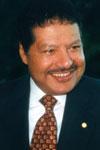Understanding longevity: From gene sequences to social inequity
03 April 2025
Published online 5 April 2011

On a recent official visit to southeast Asia, a prime minister asked me: "What does it take to get a Nobel prize?" I answered immediately: "Invest in basic research and recruit the best minds." This curiosity-driven approach seems increasingly old-fashioned and underappreciated in our modern age of science. Some believe that more can be achieved through tightly managed research — as if we can predict the future. I believe this is an unfortunate misconception that affects and infects research funding. I hear repeatedly, particularly in developing countries: "Applied research is what we need." There is nothing wrong with a nation having mission-oriented research and development to solve specific problems or to dedicate to an outreach programme, such as space exploration or alternative energy. During my visits as a US science envoy, I have emphasized that without solid investment in science education and a fundamental science base, nations will not acquire the ground-breaking knowledge required to make discoveries and innovations that will shape their future.
There are countless examples of breakthroughs from research driven by curiosity. In my first year as a faculty member at the California Institute of Technology (Caltech) in Pasadena in 1976, the late Richard Feynman and I spoke about a theoretical paper he published 20 years earlier in quantum optics that opened the field to experiments, offering a way to visualize the interaction of laser light and matter. With a smile he told me that at the time he only wanted to answer a fundamental question: if a spin moment can precess in a magnetic field, would an optical transition moment do the same? Perhaps a more common example is the development of the laser by Charlie Townes. At the 50th-anniversary celebrations of its invention in Paris this summer, Townes noted that he was driven at the start only by fundamental questions on microwave spectroscopy and how to amplify light. As I told the audience in Paris, it was curiosity that brought about my contributions to femtosecond science, for which the Nobel prize was awarded, and to four-dimensional electron microscopy to visualize matter in space and time.
Making new knowledge is neither easy nor profitable in the short term.
Quantum mechanics, relativity, and the deciphering of the genetic code are discoveries made along the same paths, as are revolutionary technologies such as magnetic resonance imaging (developed from curiosity-driven research about the spin of an electron) and the transistor (discovered as a result of curiosity about the nature of electrons in semiconductors). The manufacturing, medical and digital-information technology industries that followed now constitute the backbone of global communications and the economy. Curiosity pays!
How can we ensure that such research is encouraged today? Curiosity-driven research requires that creative scientists work in an environment that encourages interactions between researchers and collaborations across different fields. But such attributes cannot and should not be orchestrated by structured and weighty management, as creative minds and bureaucracies do not work harmoniously together. So is there a formula for managing discovery making? The answer lies in accepting a triad of essentials. First, and most important, are the people involved. Giving proper priority to providing thorough and inspiring education in science, technology, mathematics and engineering is essential. Research and development needs to attract the best young minds. Large buildings and massive funds will not produce much without the right people.
Second, an atmosphere of intellectual exchange is of paramount importance for ideas to crystallize. To distract faculty members with the writing of extensive and numerous proposals or to turn them into managers is the beginning of the end. The modern enterprise of science has become so bloated and complex that the traditional models of funding must be re-examined. How do we focus resources on the best science and what is the level of funding needed to serve society best?
Third, without resources little can be achieved, no matter how creative the mind. Obviously, investment in science is needed to build instruments and to hire competent staff. Countries and institutions that provide the requisite infrastructure and the funding for ideas will be the homes of discoveries. But such support should follow the vision of creative researchers, not be built merely to lure money or to force people into fashionable research areas such as nanotechnology.
Today, officials in many developing countries want to find ways to reach the innovation levels of the developed world. In the search, they often overlook the key roles of fundamental research and science education; regrettably, the same trend is creeping into developed countries. Political leaders must appreciate that it is the quest for new knowledge that drives innovation, and without it young students will not be attracted to the profession.
I have been fortunate to spend the past 30 years of my career in an institution that believes in such values. Despite pressure to change, I hope that Caltech will continue to preserve its unique culture as — in the words of one of my colleagues and former Caltech president, David Baltimore — a "village of science". Preserving knowledge is easy. Transferring knowledge is also easy. But making new knowledge is neither easy nor profitable in the short term. Fundamental research proves profitable in the long run, and, as importantly, it is a force that enriches the culture of any society with reason and basic truth.
Ahmed Zewail won the 1999 Nobel Prize in Chemistry. He serves on Barack Obama's Council of Advisors on Science and Technology. e-mail:zewail@caltech.edu
This article is reproduced with permission from Nature online 17 November 2010
doi:10.1038/nmiddleeast.2011.43
Stay connected: